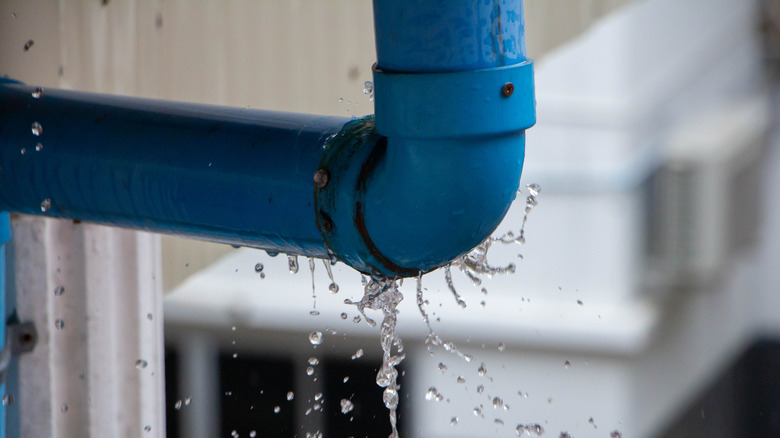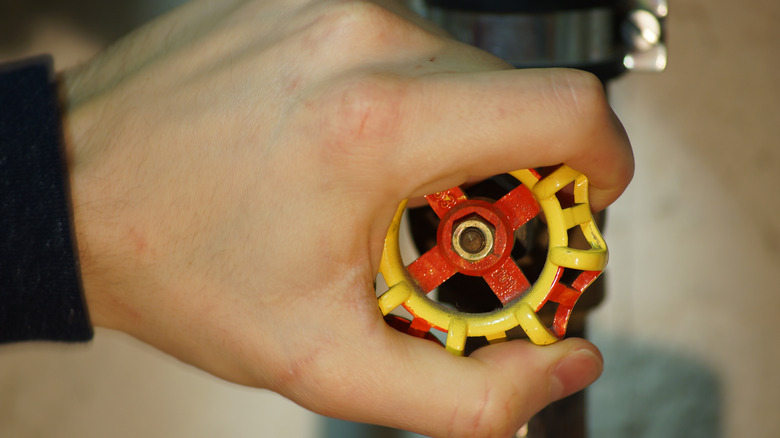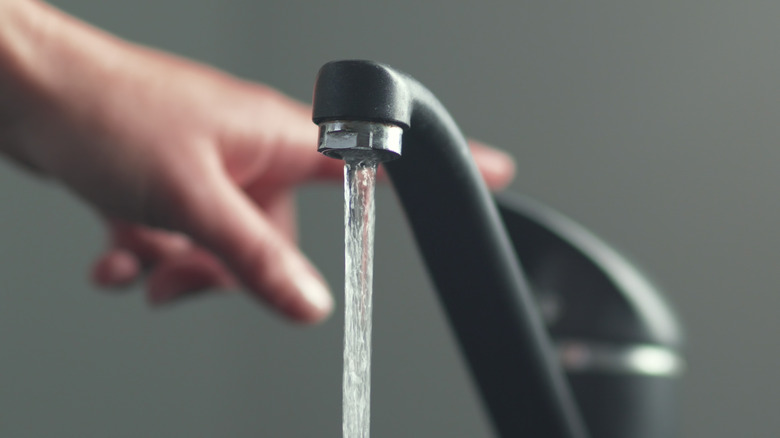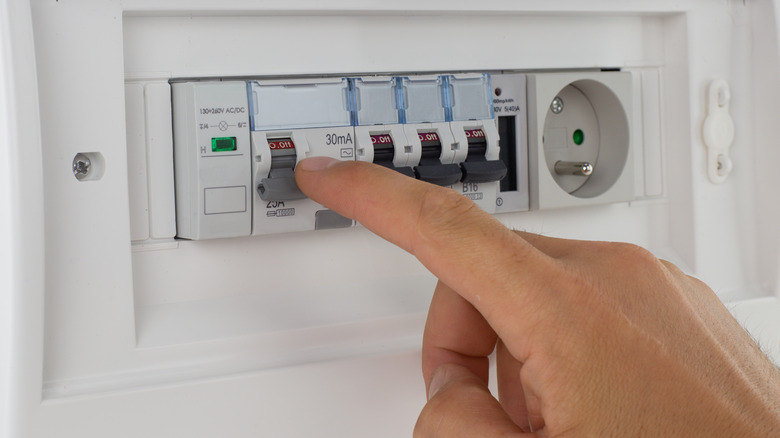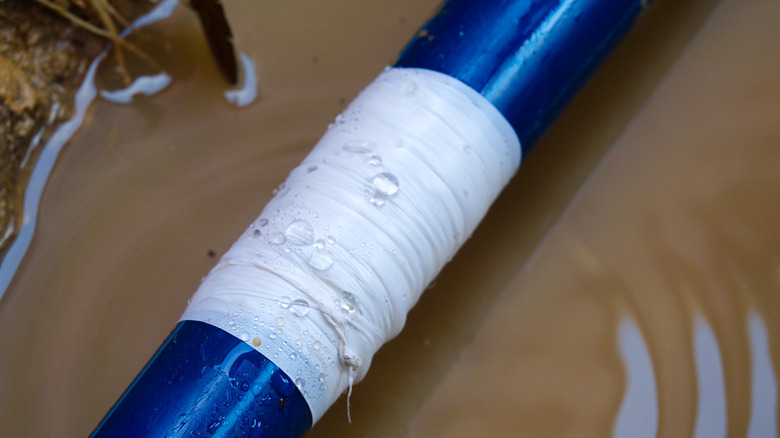5 Things You Should Do When You Find A Burst Pipe
A pipe can burst without notice and cause significant damage to your home warns The Hanover Insurance Group. The major causes of pipe breakages are aging, clogs, freezing temperatures, subpar pipework, excessive water pressure, and external pressure from its surroundings. However, some pipes are more resistant to bursting than others — for instance, according to the New England Institute of Technology, copper pipes have a lifespan of over 50 years.
Regardless of the type of pipes in your home, StaySafe.org explains that issues can be prevented by protecting your pipes with insulation, sealing leaks through which cold air can get to the pipe, and keeping water pressure in check with a pressure gauge. But note that pipe damage cannot be prevented entirely, and, especially in winter, you should keep an eye out for a burst and solve it immediately after it happens. Per M5 Plumbing Services Inc, the signs of a burst pipe include an increase in the water bill, mold problems, a change in the water pressure, and the appearance of water puddles under pipelines. Whenever you spot signs of a pipe burst, follow these tips to get the situation under your control.
Turn off the water supply
When faced with a broken pipe that's leaking water, your first course of action should be geared toward stopping the spread of water. Doing so in time will save your home from water damage. To do this, first, locate the shut-off valve and stop the water supply. If you don't know where the shut-off valve is located, Bob Hoegler Plumbing said the places to look are under your kitchen sink, in your crawlspace or basement, or in your garage.
If you can't find it in any of those places, it may be located near an outdoor faucet or underground, close to the property. After locating the shut-off valve, determine whether it's a gate valve or a ball valve design. Hiller Plumbing, Heating, Cooling, & Electrical writes that to switch off a ball valve, you should hand-turn the lever to be perpendicular to the pipe it's connected to. Meanwhile, to shut off a gate valve (pictured above,) twist the head in a clockwise direction until it stops turning.
Drain your water lines and system
After turning off the main supply, there will still be some water remaining in the pipes, so your next mission should be to empty them, which will save your entire plumbing system from further damage. But the question is, how do you drain your water lines?
Meticulous Plumbing Home Services LLC explains that first, you should turn on every shower, sink, water heater, and other fixture that dispenses water, and leave those faucets open. If your home is two stories or higher, always start the process of draining from the rooms on the upper floors and work your way down to the basement. After that, it is also advisable to drain the tanks of every toilet in the house by flushing them. Moreover, once the pipe is repaired, remember you will need to close all the faucets again, before turning the water supply back on.
Cut the electricity
Whenever there's a water leak in your home, a necessary safety precaution is to cut the electricity supply. This prevents water from coming in contact with electrically charged items and also eliminates the chances of electrocution. If you don't know the location of your main electric supply control box Art Of Manliness suggests looking for it in the garage, the basement, or on the walls outside the house — it's often a gray metal box fixed to the wall.
Within the electric box, you should find a group of switches, known as circuit breakers. The main circuit breaker is usually set apart from all the others. Switch off each of the individual breakers (branch breakers) first before you switch off the main breaker — doing otherwise may cause a severe power surge, Super D Electric warns. Having turned off the branch breakers, switch off the main circuit breaker, which is often made up of two switches.
Now that the electricity supply is turned off, you can save items within the areas affected by water from water damage without exposing yourself to electrical accidents. Clutter suggests moving items that are more vulnerable to water damage first. Heavy items that are water-adaptive may not need to be evacuated unless there's water trapped under them. After unveiling every wet area, mop and air-dry them to discourage mold or mildew growth. In the case of a flood, you may need a wet-branded vacuum cleaner to suck up the water.
Call your plumber and your insurance company
Once you have the situation under control, the next step is to call in a plumber. This is where you need to be as careful as possible. People often panic in situations like this. They impulsively call any plumber that comes to mind and, more often than not, regret doing so. To choose the right plumber for the job, GharPedia writes, consider how much the company is responsive when it comes to an emergency situation, professional in their dealings and operations, well-reputed and experienced in pipe repairs, close to you, and transparent. Good plumbers check this list. They also offer the best prices and have solid insurance and policies. Once you find one, put a call through and explain the situation to them.
After talking with the plumber, call your insurance company and make an insurance claim if your home insurance policy covers water damage. According to New Life Restoration, your insurance company would request evidence of the occurrence, so you need to make documentation through videos and pictures. Be as meticulous as possible when capturing the burst pipes and other items that might have been damaged by water.
Make temporary fixes
While you wait for backup, you can temporarily patch up the broken pipe. This is especially needed if you have to use your plumbing system but the repairers are taking forever to come in. Some of your best bets when it comes to pipe patching materials are silicone tape, pipe clamps, epoxy putty, repair tapes, and pipe wraps. To use an epoxy putty as guided by American Leak Detection, use sandpaper to smoothen the rough edges of the pipe's broken area and cover it in molds of prepared epoxy putty. After an hour, the epoxy should have hardened and closed the leaking part, so you should be able to use your plumbing system by then.
If it's a small fracture, carefully locate, drain, and dry the damaged pipe and tightly wrap a considerable amount of silicone tape or pipe leak tape around it until it's snugly and completely covered, explains Mike Diamond. However, according to PipeRepair.co.uk, pipe repair clamps will last longer and only cost about $11. However, they also suggest that you can make a homemade clamp by placing the rubber from an old bike's inner tube over the leak and securing it in position with some basic C-clamps.
